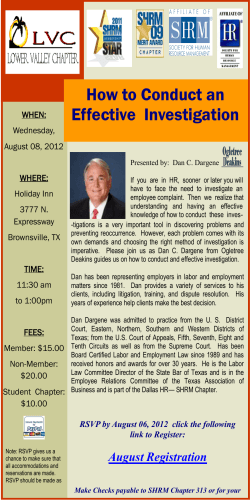
Document 93320
Tips for Helping at Home • Look for patterns in your environment. Where do you see patterns? How are patterns made? Can you find a pattern in music or in a story you read or tell? Mathematical Emphasis Investigation 1— Exploring Patterns • Observing and describing attributes • Recognizing and describing a pattern • Creating and extending patterns • Predicting what comes next in a pattern Kindergarten Investigation 2—What Comes Next? • Look at the clothing in your child’s closet. Which items have patterns and which do not? You child may want to sort his or her clothes into two groups: those with patterns and those without. • Recognizing a pattern • Constructing and extending a pattern • Reading a pattern • Predicting what comes next in a pattern • Identifying the unit of a pattern Investigation 3—Hopscotch Paths • • Make patterns together. Lots of household items are fun to make patterns with: buttons, caps and bottle tops, coins, and keys are just a few. You can also take turns and add on to each other’s patterns. Try physical pattern routines with motions, such as clapping your hands and tapping your knees in a repetitive pattern. Start the pattern and see if your child can predict what will come next. Then reverse the game, with your child making a pattern for you to extend. Website http://cms.everett.k12.wa.us/math/Kinder • Constructing and extending a pattern • Interpreting a pattern using physical movements • Recording a pattern • Representing a physical pattern using materials • Predicting what comes next in a pattern • Identifying a unit of a pattern Investigation 4—Pattern Borders • Making a linear pattern in a rectangular frame • Making and comparing patterns that use the same two variables (of color) • Copying, building, and extending patterns that grow or shrink in some regular and predictable way • Determining a rule for how a pattern grows or shrinks • Recording patterns Exploring Pattern Vocabulary Pattern - predictable elements that alternate, repeat, increase or decrease in a regular way. Game Games: The Importance of Playing More Than Once Games are used throughout the Investigations curriculum as a vehicle for engaging students in important mathe- a-b pattern - What Comes Next? Gather items such as blocks, silverware, keys, buttons, etc. matical ideas. a-b-b pattern - The more students play the games the more opportunities a-b-b-a pattern - they have to practice important skills and to think and reason mathematically. The first time or two that students Unit - the element that repeats in a pattern play, they focus on learning the rules. Once they have mastered the rules, their interest turns to the mathematical content. Staircase pattern For example, when students play Compare, they practice counting and comparing quantities. Over time, they be- One player makes a pattern and hides the last six elements of it. The other player then builds the same pattern, copying as much as is showing, and predicts what’s hidden. come familiar with addition combinations through frequent experience, rather than by rote memorization. Border pattern For many students, repeated experiences lead naturally to developing more efficient strategies for combining numbers, to reasoning about numbers and number combinations, and to explore relationships among number combinations. Glossary http://www.amathsdictionaryforkids.com/ Eston, Rebecca. Investigations in Number, Data, and Space: Pattern Trains and Hopscotch Paths. Dale Seymour Publications, 1998. What comes next?
© Copyright 2025





















